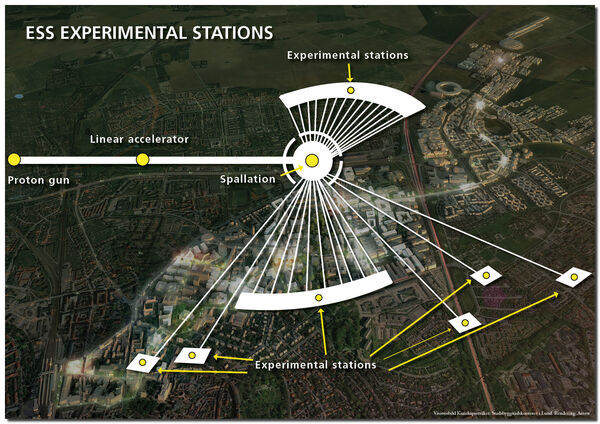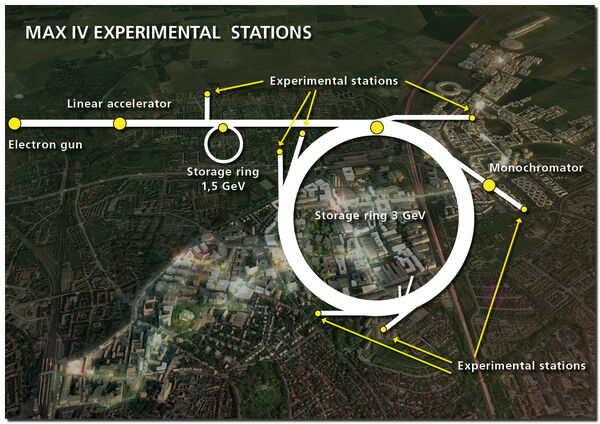ESS
Proton gun
Instructions:
- Start and stop at the button.
- Hit the drum until the electrons/protons are released!
The proton gun releases protons, which are then accelerated at high speed in a linear accelerator. Protons are produced using hydrogen. When one removes an electron from a hydrogen atom one is left with a proton. This is done by heating up hydrogen gas with a rapidly fluctuating electrical field, the electrons are thus released from the hydrogen molecules, leaving the protons. The principle is the same as boiling water in a microwave oven, but the frequency is much higher and the effect much stronger.
Linear Accelerator
Instructions:
- Press and release the buttons to accelerate the ball.
The protons are accelerated in a 500-meter long linear accelerator with the help of high frequency electrical fields. Good acceleration requires the timing of the high frequency electrical fields to be optimal. Magnets positioned down the whole length of the accelerator focus and direct the beam along the right track. After about 40 meters the protons have achieved enough speed for the acceleration to take place with the help of superconducting cavities. These are cooled from the outside with liquid helium to -271 degrees Celsius.
Spallation
Instructions:
- Get a proton with the black handle.
- Shoot it to free the neutrons!
Spallation means that neutrons are released when a proton at high speed hits an atom nucleus. Protons that are accelerated in a linear accelerator are fired at a rotating disc made of Tungsten, where a certain number of Tungsten atoms are hit. Thanks to the high speed of the protons, every proton can release around 30 neutrons.
Experimental Stations
Instructions:
- See the difference between light in ESS & MAX IV.
In the experimental stations, neutron beams are used by researchers to study their samples. The sample to be examined is placed in the neutron beam in the instrument. The neutrons penetrate the sample and some of them spread out, bouncing against the atomic nuclei in the material. By measuring the speed and direction of the neutrons when they come out of the test one can, with advanced software, get what is known as a spread pattern. This spread pattern is analysed and gives information on how the atoms are positioned in relation to each other inside the sample, and how they move. This then reveals how the sample appears and functions at a molecular level.
MAX IV
Electron gun
Instructions:
- Start and stop at the button.
- Hit the drum until the electrons/protons are released!
The electron gun releases electrons, which are then accelerated at high speed in the linear accelerator. The electrons can be released by heating. When the electron gun’s cathode of barium oxide coated Tungsten is warmed to around 1000°C, electrons are released and become free flying. The free flying electrons are accelerated from rest up to virtually the speed of light, by strong electrical fields.
Linear Accelerator
Instructions:
- Press and release the buttons to accelerate the ball.
The electrons are accelerated in a linear accelerator, which is housed in a 300-meter long underground tunnel. The linear accelerator accelerates the electrons with the help of high frequency electrical fields. Good acceleration requires that the timing of the high frequency electrical fields is optimal. Magnets positioned down the whole length of the accelerator focus and direct the beam along the right track. In the linear accelerator the electrons travel at close to the speed of light and their energy increases during their passage through the accelerator.
The Storage Ring
Instructions:
- Use the pump to spin the electron fast!
- Bring the wiggler towards the pipe.
- Create light!
After the linear accelerator, the electrons travel into the storage ring. They are steered by magnets that bend the electron beam into a circular track. When the electrons travel forward in the storage ring, in the straight stretch before the beam pipe, they pass through a device of magnets called a wiggler. A wiggler is made up of a lengthy series of magnets that cause the passing electrons to swing something like a slalom skier. When the electrons swing they send out an intensive synchrotron light that travels straight forward into the beam pipe. At the end of the beam pipe the light meets the experimentation stations and the researcher’s sample. The electrons continue to go round and round in the storage ring.
Experimental Stations
Instructions:
- See the difference between light in ESS & MAX IV.
At MAX IV there will be many different experimental stations where samples of material are examined in different ways. A typical way is to light the sample with synchrotron light. The light is shone over the electrons present in the material, creating a spread pattern or what is known as a diffraction pattern. This pattern is processed numerically in a computer to create a picture of the molecules or atoms being examined.
Monochromator
Instructions:
- Use the left stick to choose whether the light should pass through gratings, a mirror or a prism.
- Move the right stick so that the light goes into the slit.
- Look at the computer screen to see which of the wavelengths of light that has arrived at the sensor.
By changing the sticks you can select different wavelengths of light.
At MAX IV researchers can choose to use light with different wavelengths, from infrared light to x-rays. Researchers select a particular wavelength to examine their samples. They can do this by filtering away the wavelengths that they don’t want. The filter is called a monochromator and most commonly comprises mirrors, a grating and a slit. The grating is a surface with a small pattern repeated over it. It can be turned mechanically so that the light with the chosen wavelength passes through the slit.
- Synchrotron light is electromagnetic energy comprises x-ray radiation and visible light. Visible light consists of all colours of the rainbow. What distinguishes the colours apart is that they have different wavelength.
ESS & MAX IV
Spectral Analysis
Instructions:
- Press the button on the cabinet, to turn on the light source.
- Look at the spectrum visible to the side of the light source and compare with the spectrum map on the wall beside the cabinet.
- Move the grid (window handle) and figure out which gas it is at the next light source!
A spectrum is a separation of light into different colours, a sort of fingerprint of the substance emitting light. Each substance gives a unique set of colours. By analysing a spectrum in an unknown gas one can determine what atoms a gas contains. At MAX IV samples are illuminated with synchrotron light and the researchers analyse the light from the samples. The emitted light tells which substances the sample contains, for example which iron compounds are found in the 17th century Vasa warship. At ESS the equivalent method of measurement is called neutron spectroscopy. Neutrons with a particular energy are sent into the sample and their energy is measured when they come out. The difference in energy gives information on the material’s dynamic condition, for example vibration and rotation.
Light produces colour
Instructions:
- The painting utilizes particular colours so that aspects of the pattern change when illuminated by light of various wavelengths.
Researchers can analyse the same sample at both ESS and MAX IV. They can thus supplement the information about their sample. At MAX IV the samples are illuminated by light. Depending on the colour of the light that is used, one gets different information about the sample. In order to study something as small as molecule structures, ultraviolet light or x-rays are used, the shorter the wavelength, the smaller the structures can be measured. At ESS the samples are struck with neutrons. With the help of these studies, a further picture of the material being examined is obtained.
The painting, made by Diane Sandall, utilizes particular colours so that aspects of the pattern change when illuminated by light of various wavelengths.
Electromagnetism
Instructions:
- Start
- Change the force of the magnetic field.
- Turn the magnetic field.
Electromagnetism is a branch of physics involving the study of the electromagnetic force, a type of physical interaction that occurs between electrically charged particles. The electromagnetic force, which is carried by electromagnetic fields composed of electric fields and magnetic fields, is responsible for electromagnetic radiation such as light. It is one of the four fundamental interactions (commonly called forces) in nature, together with the strong interaction, the weak interaction and gravitation. At high energy, the weak force and electromagnetic force are unified as a single electroweak force.
Video-game
Instructions:
- Follow instructions on the screen.


